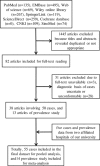Cryptococcal meningitis in systemic lupus erythematosus patients: pooled analysis and systematic review
- PMID: 27599471
- PMCID: PMC5113055
- DOI: 10.1038/emi.2016.93
Cryptococcal meningitis in systemic lupus erythematosus patients: pooled analysis and systematic review
Abstract
Cryptococcal meningitis is an important fungal infection among systemic lupus erythematosus patients. We conducted a pooled analysis and systematic review to describe the epidemiological and clinical profile of cryptococcal meningitis in systemic lupus erythematosus patients. From two hospitals in China and nine literature databases, cases and prevalence data were collected for pooled analysis and meta-analysis, respectively. Categorical variables of cases were compared using a χ(2)-test on the statistical program of SAS. A multiple regression analysis was performed to ascertain independent predictors significantly correlated with prognosis. Meta-analysis was conducted by the statistical program of R. The prevalence of cryptococcal meningitis in systemic lupus erythematosus patients was 0.5%. Patients were predominantly females and adults. A prednisone equivalent of more than 30 mg/day before infection was associated with higher mortality (odds ratio (OR)=9.69 (1.54, 60.73)). In all, 36.8-38.9% patients showed low lupus activity when they developed the crytococcal infection. Moreover, 38.2% of the patients were misdiagnosed. The estimated case-fatality rate was 23.6%. Our results suggest that more emphasis should be placed to further understand lupus-related cryptococcal meningitis and to develop better prophylaxis and management strategies to combat this condition.
Figures



References
-
- Chen HS, Tsai WP, Leu HS, Ho HH, Liou LB. Invasive fungal infection in systemic lupus erythematosus: an analysis of 15 cases and a literature review. Rheumatology (Oxford) 2007; 46: 539–544. - PubMed
-
- Chen GL, Chen Y, Zhu CQ, Yang CD, Ye S. Invasive fungal infection in Chinese patients with systemic lupus erythematosus. Clin Rheumatol 2012; 31: 1087–1091. - PubMed
-
- Gonzalez LA, Vasquez G, Restrepo JP, Velasquez M, Ramirez LA. Cryptococcosis in systemic lupus erythematosus: a series of six cases. Lupus 2010; 19: 639–645. - PubMed
-
- Abbott NJ, Mendonca LL, Dolman DE. The blood-brain barrier in systemic lupus erythematosus. Lupus 2003; 12: 908–915. - PubMed
-
- Hagen F, Khayhan K, Theelen B et al. Recognition of seven species in the Cryptococcus gattii/Cryptococcus neoformans species complex. Fungal Genet Biol 2015; 78: 16–48. - PubMed
Publication types
MeSH terms
Substances
LinkOut - more resources
Full Text Sources
Other Literature Sources
Medical
